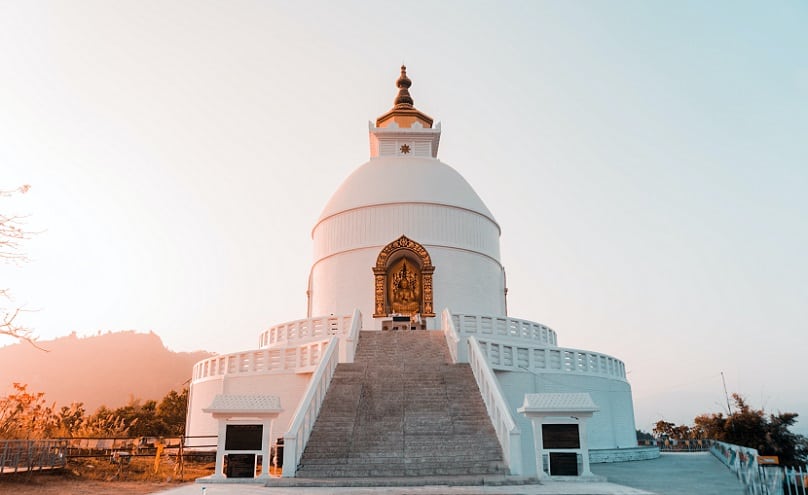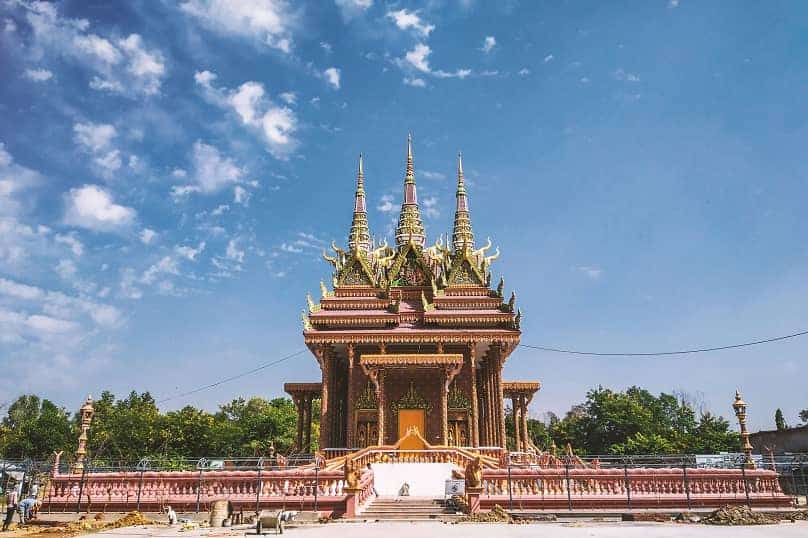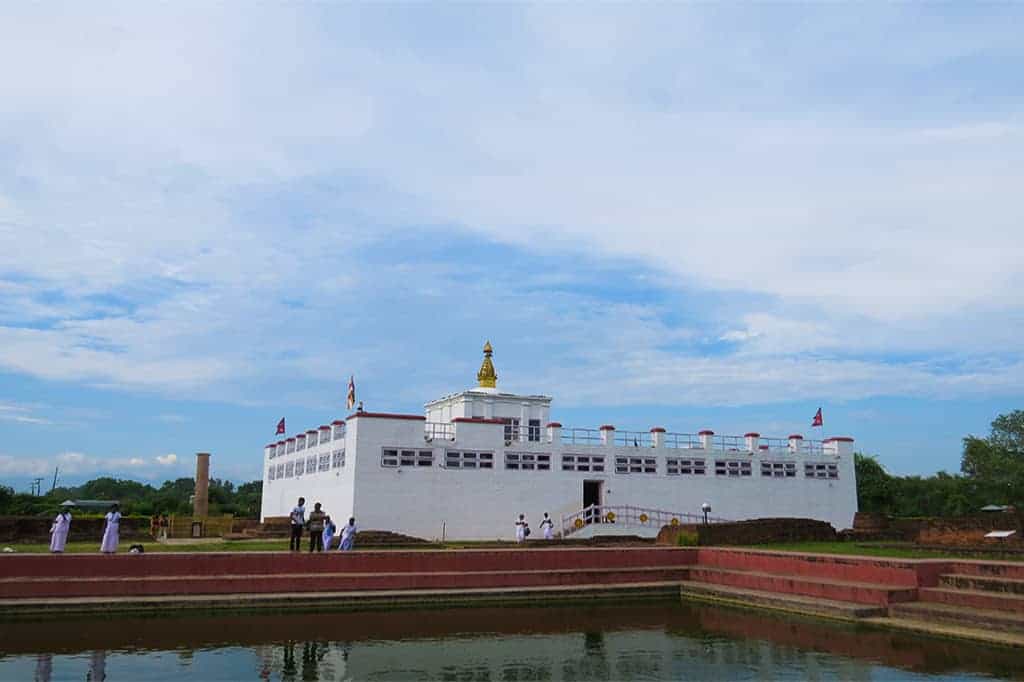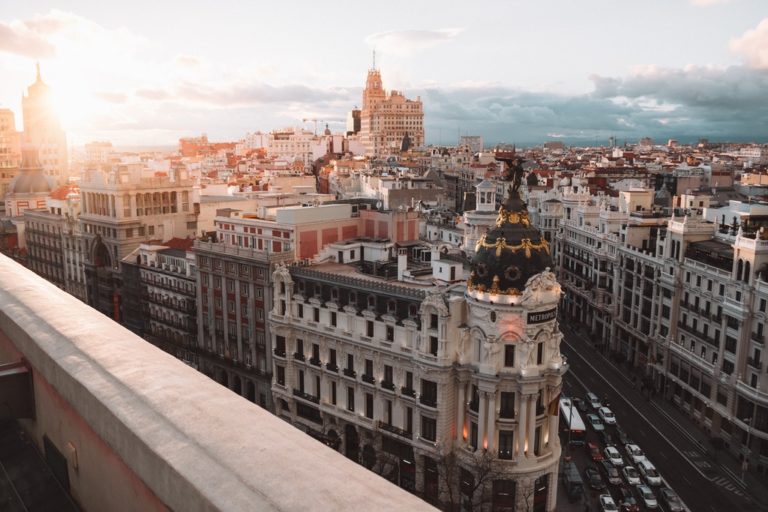Lumbini: A Comprehensive Traveler’s Guide
“Buddha was born in Nepal,” a slogan that you will see a lot while researching Nepal. You will also see this on the booklets on your travel to Kathmandu, Nepal.
Oh! And not forget, once you reach Kathmandu, you will see these words imprinted on t-shirts. You can even see them on the sides of the local buses and trucks in Nepal.
One thing is real. Nepal takes pride in the fact that one of history’s most respected figures, Gautam Buddha, was born in this country’s Lumbini. Due to this, people consider it a very sacred site.
Lumbini has floods of travelers from across the globe every year. The city falls in the Rupandehi district of Nepal. This town is very close to the Indian Border.
For me, it is a city like a coin with two sides. One side of the town has clean and managed attractions. On the other hand, the place can be hectic, humid, and full of flies.
Of all the places, the Lumbini Sanskritik Municipality is a holy site. It is a significant destination that demands the pilgrims and travelers looking for spiritual healing to explore it.
The Holy Sites is also listed as a UNESCO World Heritage Site. It is because of its history, monuments, monasteries, and natural and cultural wonders.
Traveling here needs to be thoroughly planned. The sites have their specific timing, and the weather challenges you till you have sweat all over and give up.
So, for this reason, I have created a comprehensive guide on traveling to Lumbini. Hop on! As I take you on a historical drive to Gautam Buddha’s birthplace.
History of Lumbini
The history of this place has two sides: the legends and the written data.
Legends
According to Buddhist legends, Gautam Buddha’s mother, Maya Devi, was traveling to her paternal home in Kapilvastu. On her way, she went into labor at Lumbini.
People say that Maya’s birth-giving process was painless. Gautam Buddha (Siddhartha Gautam, by birth) was born while she was standing between twin Sala trees.
After he was born, baby Gautam immediately spoke the words, “This is my final rebirth.” As crazy as it sounds, the newborn baby took seven steps, marking the cardinal directions starting from North.
Legends say that a lotus flower grew out from each of his steps. Divinities then washed the mother and child at a nearby pond (now Pushkarna Pond). Even now, you can see the tradition of bathing the statue of Buddha at Buddha Jayanti (Birthday of Gautam Budhha).
Sadly, Siddhartha Gautam’s mother died seven days after his birth. Then, Maya Devi’s younger sister, Mahaprajapati, became his foster mother.
Born into an aristocratic family, Siddhartha became curious after seeing his people’s sufferings. He was motivated by an existential concern for the human condition. And thus, he left his comfort of living in a palace to find the answers to human suffering.
He went on a religious quest. After a lot of meditation and learning, he got enlightenment at Boddhagaya. He then became the Gautam Buddha.
Discovery
It is famous as the birthplace of Lord Buddha. After a German archaeologist, Alois Führer rediscovered some Buddhist structures built by King Ashoka and the Maya Devi Temple. It covers the actual birthplace of Buddha.
They discovered the birthplace indicated by the marker stone in 1996 CE. As the legend has it, the holy pond, where Buddha and his mother took their first bath, was right in front of the temple, too.
Most importantly, the historical facts were written in a pillar erected by the Indian Emperor Ashoka in 248 BCE. This pillar commemorates the birth of Siddhartha Gautam. It gives us the belief that the fact that Buddha was born in Lumbini prevailed before King Ashoka.
Two Chinese monk-pilgrims, Faxian in the 5th Century and Xuanzang in the 7th century have recorded their visit. The records describe the Ashokan Pillar and the existence of the pond.
Today, it invites followers of Buddhist philosophy from all around the world. It gives a historical journey into the life.
Best Time to Travel to Lumbini
It falls in the Terai region of Nepal, and it is relatively hot most of the year. The best time to travel is in autumn (October – November). It is when the temperature is dry and moderate.
If you want to visit, you should in April and May. The city comes to life in celebration of Buddha Jayanti.
AVOID summer season. Summer is an off-season for a reason, folks! The weather will be hot and humid, and the scorching sun will not let you explore the holy city barefoot. It will feel like walking on lava.
How to Reach to Lumbini
Lumbini is accessible by flight and by road.
i. By Flight
If you want maximum comfort or a quick day tour, flying to Bhairahawa’s Gautam Buddha Airport will be the best. It does not have a domestic airport. But don’t worry; the Bhairahawa airport is just an hour’s drive from the city.
Nepal has only one international airport in Kathmandu. So you can fly from your country to Kathmandu’s Tribhuwan International Airport. And then take a domestic flight to Bhairahawa.
But hey! There is good news. The airport at Bhairahawa is being made into an international airport, opening soon.
There are many domestic airline options; you can choose from them. Some choices are Yeti Airlines, Buddha Airlines, and Shree Airlines. Just hop on the first flight to get the most out of your day trip.
Price:
$116 for a one-way flight
ii. By Road
Roadways are also a good option for traveling. Lumbini is 272 kilometers away from Kathmandu. It takes about 8-10 hours, depending on your transportation means.
If you are traveling from Chitwan, then it is just a 3-4 hour drive. So let’s go through the options of traveling by road.
a) Tourist Bus
A tourist bus is the cheapest and most comfortable way of traveling. These buses offer comfortable seats. Most have air-conditioning and device charging capabilities.
Tourist buses also provide a one-time lunch buffet on their package and a bottle of water on your journey. They also promise you free onboard wifi, but it doesn’t work.
Many tourist buses go to Lumbini from Kathmandu. You can choose from companies like Graceful Travel and Yatra Nepal.
Price:
Kathmandu – Lumbini: $10.02
Lumbini – Kathmandu: $10.02
b) Local Buses
Local buses are also available from Kathmandu to Bhairahawa.
They do not have an air-conditioning facility, and you may be a victim of open windows and pollution. Not to forget, you will have to catch another bus after you reach Bhairahawa. But on the positive side, it is cheaper than the tourist bus and will get you to your destination anyway.
Price:
Kathmandu- Lumbini: $5-$7
Bhairahawa- Lumbini: $0.5- $1
c) Taxi
Hiring a local taxi from anywhere, Kathmandu, Pokhara, or Chitwan, will be a good option. A taxi will allow you to make a quick stop anywhere you want. It lets you enjoy the scenic beauty of the hills on your way to the Terai region.
However, since you will not be associating with a travel agency, you must haggle. The taxi driver may ask for higher pay.
d) Train
If you travel from India, taking a train to Gorakhpur will be best. From Gorakhpur, you can take a bus to Sunauli. You will get buses from here that will take you to Lumbini.
It may sound a bit hectic, but it is worth the price.
How to travel around Lumbini
The city has a sound roadway system and pitched roads.
The best way to get around the Lumbini Sanskritik area and the whole of Lumbini is by hiring a bicycle. You can hire one from Lumbini Village Lodge at Lumbini Bazaar for $1.25 daily.
You can also hire an electric rickshaw to get you around the town for $1.67 per hour.
Tuk-tuks and normal rickshaws are also available. However, they may charge you NPR 1000, that is $8.36, to get you around the attractions for some hours. That is EXPENSIVE!
Since it is too hot to travel on foot, I recommend you ride these options to get around town. However, try to haggle and minimize the charge as much as possible. The drivers tend to exaggerate the prices when they see a tourist.
Major Attractions of Lumbini
It is a Buddhist pilgrimage hub. It has been attracting many tourists for its rich history and culture.
This city also has many ancient artifacts that date back to the 4th century. Many renowned archaeologists had found them. So, this is also the right place for people interested in archaeology.
Below, I have listed 11 attractions of Lumbini. They will make you feel like you are traveling to many countries simultaneously. You can enjoy them all the while feeling enlightened.
i. Maya Devi Temple
Maya Devi Temple is the most crucial attraction. It is where Buddha’s mother, Maya Devi, went into labor. She gave birth to him here while traveling to her paternal home.
Adjacent to the temple is the Pushkarna pond, where Buddha and his mother took their first bath. People consider the Maya Devi Temple a very holy site for Buddhist pilgrims. You will find many devotees praying and meditating on the wooden floor of this dimly lit temple.
Archaeologists have found evidence of the oldest Buddhist Shrine from this place. It is now preserved in the Lumbini Pilgrimage Center. I suggest you visit the temple early in the morning as the daytime tends to get hot and crowded.
You cannot wear shoes inside the temple’s premises, and trust me; the ground gets so hot that you will be jumping your way inside the temple (speaking from experience!).
Right next to the temple is the Bodhi tree, where Maya Devi rested. Prayer flags cover the Bodhi tree and its surroundings. It has a very peaceful vibe.
You will also hear the chanting of prayers from monks and pilgrims. Among all the sites, this is the only attraction that charges money for a visit.
Price:
Foreigners: $1.67
Locals/SAARC Nationalities: $0.25
ii. Ashoka Pillar
Ashoka Pillar is among other famous attractions. It has an inscription of King Ashoka’s pilgrimage tour to Lumbini, written by a third party.
King Ashoka was a ruler of the Mauryan Empire. He resorted to the Buddhist principles of non-violence after witnessing the loss of lives in a war. He has built many pillars on the tenets of Buddhism, and one happened to be in Lumbini.
Alois Anton Führer discovered the pillar. He found them after going through the historical records. Two ancient Chinese monk-pilgrims, Xuanzang and Faxian, made these records.
Now, a small fence secures the pillar. People have decorated it with colorful prayer flags. You should light up some incense sticks to respect the gods while you are here.
iii. World Peace Pagoda
You can find a series of Peace Pagodas around the world. Most of these were built under the guidance of a Buddhist monk from Japan, Nichidatsu Fuji. One of them happens to be at Lumbini.

The best time to visit this pagoda is the sunset, as mornings and afternoons tend to be too hot. The World Peace Pagoda and its gardens are a great place to meditate, stroll around and relax. Plus, it is also a perfect location to take Instagram-worthy photos.
iv. Cambodia Monastery
Cambodia Monastery is one of the many monasteries that NEEDS exploration. Cambodia Monastery’s construction was recently completed in 2018. It is one of the fascinating monasteries with a strong touch of Angkor Wat.

A square railing surrounds the temple with four 50-meter-long green snakes—one for each cardinal direction. Intriguing architectural bliss that awes any visitor fills the monastery.
It feels like exploring the Angkor Wat in Cambodia.
v. Chinese Buddhist Monastery
Zhong Hua Chinese Buddhist Monastery, simply known as the Chinese Buddhist Monastery, is the most beautiful temple.
The dogs of Fo flank are the gateway to the monastery. After this, you will see a courtyard filling your heart with serendipity. The pagoda-styled architecture makes the monastery look like the Forbidden City’s replica.
The Chinese Buddhist Monastery also has meditation cells and prayer rooms for visitors.
vi. Royal Thai Monastery
While most monasteries have colorful designs, the Royal Thai Monastery has a clean white aesthetic. It pleases every minimalist. The government of Thailand had funded this monastery.
The monastery was constructed with white marble.
It also has a blue-roofed meditation center nearby. It is another beautiful piece of architecture. When you are here, make sure to try Thai sweets, which cost NPR 50/ $0.42
vii. Myanmar Golden Temple
The Myanmar Golden Temple is one of the oldest structures in Lumbini. It is perhaps the most historically important one too.
The temple has a corncob-shaped Shikhara (tower). It was shaped after the Temples of Old Bagan.
The structure makes the pagoda stand out from other temples.
There are three prayer halls inside the Myanmar Golden Temple premises. The temple also houses the Lokmani Pula Pagoda. It is a Burmese-styled stupa inspired by the Shwedagon Paya in Yangon.
Plus, the numerous paintings at the temple make it more worth the visit.
viii. Korean Buddhist Temple
This Korean Buddhist Temple is also known as Dae Sung Shakya. The South Korean government had built this temple.
The temple has intricate architecture constructed to preserve the Korean heritage. And I believe that the Korean government has been successful in doing so. Visiting this temple makes you feel like you are traveling in Korea.
The temple lets you meditate in the courtyard with the monks and pilgrims. The temple also offers a community sleeping area and provides three meals a day for a few days for $4.15 per day. I’m sure you will feel closer to nature and grow spiritually while staying here.
Just make sure to book your stay or inform pre-hand about your incoming. If you fail to do so, you will have no place to stay. The temple has some set of rules that keep changing and allow only a limited number of people to stay.
ix. German Monastery
Great Drigung Kagyud Lotus Stupa, popularly known as the German monastery, is an extravagant stupa. The German Tara Foundation constructed this monastery.
The German monastery has great historical significance. It was built under the guidance of two great Rinpoches.
The stupa’s roofs have carvings of some Buddhist teachings. The monastery has beautiful combinations of gold, wood, and wood carvings.
There is also a small pond in front of the monastery premises, with a tiny frog statue. People believe you will find luck if you can place the coin on the frog.
x. Lumbini Museum
Located at the northern end of Lumbini Sanskritik, the museum is a beautiful art. The world-famous Japanese architect, Kenzo Tange, designed it.
The museum is perfect for understanding Lumbini’s history and culture. It dates back to the 4th century.
It houses a collection of books about architecture and cultural life. It has preserved many artifacts, terra cottas, coins, and religious manuscripts.
These manuscripts existed from the time of Maurya and the Khushana dynasty.
The museum also has a model of the Master Plan for Lumbini’s Development Zone. You can see it and imagine what this city will look like in your future visit.
Right on the opposite side of the museum is the Lumbini Research Institute (LIRI). It provides research facilities for Buddhism and other religions.
xi. Lumbini Crane Sanctuary
By now, you know that Lumbini is an important Buddhist pilgrimage site. You did not know that it is also a sanctuary for cranes.
The Lumbini Crane Sanctuary covers over 6 square kilometers of land. It aims to protect the endangered Sarus Cranes around its wetlands.
You can also see an antelope-like blue bull at this sanctuary. You can see the cranes from the World Peace Pagoda, too, as it is quite close to the sanctuary area.
If you love wildlife and nature, then it is a must-visit place to go. The entrance is free of cost.
These were 11 of the must-visit attractions here. It would also be best to visit the Vietnam Phat Quoc Tu Temple, Dharma Swami Maharaja Buddha Vihar, and Thrangu Vajra Vidya Monastery.
All of these places are open from 8 AM to 5 PM.
Things to do in Lumbini
So you have visited all the religious sites and museums, so what more is there to do? Read on to learn about the activities that you can carry out.
i. Eat Street Snacks
The Terai region of Nepal has some authentic street snacks. These snacks leave your taste buds satiated. Personally, of all the street snacks, I love the Fulki.
For those of you who have tried Pani Puri (an Indian street snack), Fulki is somewhat like that. The difference, however, is that Fulki has warm yellow pea curry as a topping.
Papdi Chat is also a great item that has toppings of curd and tamarind chutney on flour-based chips. If your tummy can handle eating street meals, you should try the Nepalese noodle soup, Thukpa.
ii. Watch the farmers on the paddy field
The Terai region of Nepal is also known as the granary house of Nepal. It produces food for the whole nation. Walking half a day off to watch the farmers carrying out their daily lives will fascinate you.
Unlike all the other developed countries, Nepal is still lagging in technology. The farmers still use traditional methods for irrigation.
Watching them work hard, with buffaloes and cows’ help, to irrigate the land is a sight to see. You can get insights into the local’s daily livelihood and know more about their culture.
iii. Meditate
One of the best things to do in Lumbini is meditation. It is a sacred site with a tremendous spiritual aura. It enhances your mind and body while meditating.
You can meditate at most of the monasteries. Meditating under the Bodhi tree or with the monks will undoubtedly be a new experience for you.
You can also go to meditation centers like Dharma Janani and Panditarana. You can register for the courses that are most suitable for you.
It can be a one-day course or a long 10-day course. All in all, you will find your inner peace.
iv. Visit nearby places
Plan a day trip to nearby cities like Tilaurakot and Butwal.
• Tilaurakot
Tilaurakot is where Gautam Buddha resided at his palace. You can see the castle entrance through where Buddha lived in search of enlightenment.
• Butwal
Butwal is another city to visit, which is highly influenced by urbanization. It is a better place to stay the night while on your visit.
Butwal is only 11.4 kilometers away. You should spend some days at this place and visit some attractions of this city like:
• Sidha Baba Temple
• Manimukunda Park
• Banbatika Zoo and Park
• Hill Park
Currency
People accept Nepalese and Indian currency, as the city is near the Indian border.
However, be careful with the exchange rates while buying anything. Sometimes, you may get charged more than you need to pay. Make sure to clarify what currency you are using to the shopkeeper.
The best way to handle currencies is by downloading a currency converter on your phone. There are many foreign exchange offices on the Main Bazaar. They will readily change your currency to the Nepalese rupee.
ATMs are also available but will charge a certain amount for transactions.
Hotels in Lumbini
It does have hotels and lodges where you can stay the night for cheap. Well, I wouldn’t say that all have top-class bedding and food, nor will I say that it is awful.
You can get the most expensive hotels at the price of a middle-class hotel in Kathmandu or Pokhara.
Luxury Hotels
• Lumbini Hokke Hotel
• Hotel Lumbini Garden New Crystal
Middle Ranged Hotels
• Buddha Maya Garden by KGH Group
• Lumbini Buddha Garden
• Hotel Nans Lumbini
Budget Hotels
• Lumbini Garden Lodge
• The Lumbini Village Lodge
I would not recommend you stay at budget hotels as the bedding will be inadequate, and you will be a victim of mosquito bites. Plus, it is a humid place, and all you will get is a fan if you are lucky enough.
If you want to stay at Butwal instead, the city offers some pretty good hotels. Some of my favorites are:
• Hotel Club De Novo
• Hotel Avenue
• Arambha Resort
Food
You will not find an “A Class” restaurant that serves continental dishes. The restaurants and café will surely provide excellent Nepalese meals. They also offer typical snacks like burgers, fries, and pan pizza.
I don’t want you to expect much of the variety of food. I have listed some of the restaurants with good food and proper hygiene.
• The Doko Restaurant & Bar
• GG Café & Restaurant
• Lumbini Invitation 365 Restaurant
If you are staying at Butwal, then some of my favorites are:
• Black Forest
• Refresh Café
• Maitri Restaurant
Nightlife in Lumbini
Lumbini does not quite have a booming nightlife. However, its neighboring city, Butwal, is famous for hosting many parties. It has bars and clubs where you can relax after a long day of exploring Lumbini.
Below, I have listed some fabulous places at Butwal where you can have a great night with good music and food.
• The Concept Club and Pub
• Ojas Lounge and Club
• Flavour Lounge & Live Music
• Lime & Lemon
Things to Remember
i. It is a religious site. So, I suggest you wear an appropriate outfit if you do not want the locals and other pilgrims to scorn you.
ii. Bring an umbrella or a cap if you do not want to get tanned. Plus, always wear sunscreen.
iii. Buy Odomos cream to repel mosquito bites. You can also buy Mortein mosquito repellent for as cheap as NPR 70/ $0.60 in any local shop.
iv. Always haggle for prices in terms of transportation. The drivers will always ask you for higher rates. And DO NOT fall for their emotional manipulation.
SIM Card
You have two SIM Card companies to choose from in Nepal: Nepal Telecom (NTC) and Ncell.
You can get these SIM Cards as soon as you land at Tribhuwan International Airport, Kathmandu. NTC even provides free SIM Cards for tourists. You will have to buy the data packages, though.
However, if you wish to buy it outside of the airport, it will cost you $1. You can buy a 1 GB data pack for $5 if you choose NTC, whereas Ncell is much cheaper and gives you 1.2 GB data for just $2.
If you have anything else you’d like me to add, please feel free to comment below.







